Amanita phalloides
Mushroom Deaths – How Many Are There?
Published
1 year agoon
By
admin
Some we eat in salads, some we eat to get high. Some we’re told not to ingest, or we’ll likely get sick and die. No, that’s not meant to be a poem about mushrooms, but it does bring up some questions. Like, how dangerous are mushrooms in general? How many mushroom deaths occur in the world? And which species cause the most damage?
Mushrooms
Mushrooms, also known as toadstools, are a type of fungi that grow fruiting bodies which release spores as a means of procreation. Though they differ in how they look, they tend to have a stem, and then an umbrella-like head. They come in different colors, sizes, and contain a variety of different compounds. Some we eat regularly, some we’re told to stay away from, or we’ll die. There are about 14,000 known and documented species.
One of the interesting things common to all mushrooms, is the use of a mycelium network. This is not strictly for mushrooms, and applies to some other fungi as well. Mycelia are tiny thread-like structures, which on their own are known as hyphae, but together, are known as mycelium. The threads are produced by each spore, but remain incapable of reproduction sexually until they come together with other compatible mycelium.
The mycelium is considered monokaryotic when its non-sexual, and becomes dikaryotic, when it is sexualized, and ready to produce mushrooms. There is evidence that mycelium networks are also employed for a form of communication between plants; like in the form of releasing chemicals to warn other plants of danger.
Nice to have you with us. Check out our direct email updates with the Cannadelics Weekly Newsletter, and get yourself top notch offers on everything from cannabis buds, vapes and related paraphernalia, to edibles, smoking devices, cannabinoid compounds (like delta-8), and a ton more. Let’s all get stoned the right way!
What mushroom is the most dangerous?
Obviously right now we’re not talking about the mushrooms in your salad. We’re warned all the time that eating the wrong mushrooms can lead to horrifying consequences. But which specific mushrooms are these? And can we always easily tell them apart from mushrooms that won’t make us sick and/or die?
In this publication, we usually focus on psilocybin and Amanita muscaria mushrooms. Though they come from entirely different plant genera, both have the commonality of producing a psychoactive and hallucinogenic high when ingested. Neither type of mushroom is associated with deaths, though either can make a person sick. If you eat too many psilocybin mushrooms, you could irritate your stomach, and/or have a bad trip. And Amanita muscaria have a compound (ibotenic acid), that can make a person ill if the mushrooms are not prepared correctly.
Funny thing, the second mushroom mentioned, is actually considered a ‘poisonous mushroom.’ While psilocybin mushrooms are classified as ‘psychedelic’, all amanita mushrooms are classified as ‘poisonous.’ And though Amanita muscaria mushrooms aren’t deadly, other amanita mushrooms within the same genus, really can make a person sick enough to die. In fact, the genus amanita is home to the mushroom species most responsible for causing deaths.
Which one is it? Amanita phalloides, aka (appropriately) Death Cap, which is found in abundance in Europe. Estimates say that as many as 50% of all mushroom deaths, are from these amanita mushrooms. Though they don’t look like our spotted, high-inducing friends, they do look like other edible mushrooms like straw mushrooms and Caesar’s mushrooms.
Though Amanita muscaria are considered poisonous mushrooms, no deaths are attributed to them. The one notable – but unconfirmed – possibility of death, comes from the story of Count Achilles de Vecchj. In terms of these mushroom, with the correct preparation (boiling), they don’t need to make a person sick at all. However this method will not work for Amanita phalloides, or other amanita mushrooms with amatoxin compounds, as these deadly compounds are not affected by heat.
These deadly ‘amatoxins‘ are also found in the genera Lepiota, Galerina, and Conocybe. Together they are responsible for as many as 90-95% of mushroom poisonings and deaths worldwide. Amanita phalloides is responsible for the grand majority, possibly because they are often mistaken for edible mushrooms.
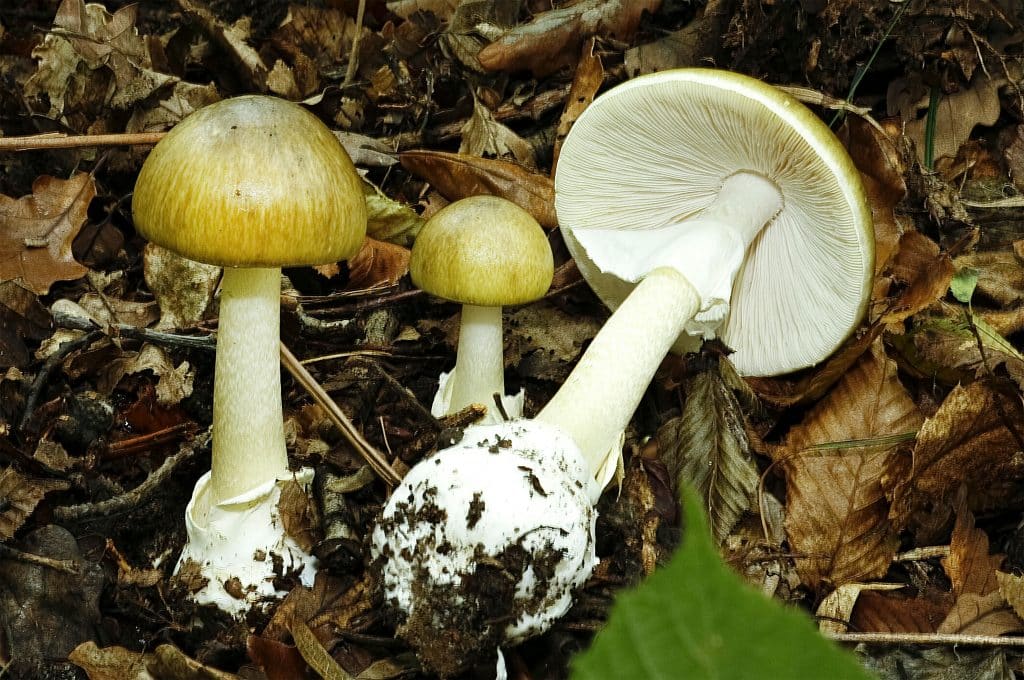
How will you know if you accidentally consumed one? Well, you’ll have to wait 6-12 hours for symptoms, which include extremely intense abdominal pain, vomiting, bloody diarrhea, and mass dehydration. Following this, the liver, kidneys, and central nervous system are affected, which eventually leads to a coma, and death occurs in more than 50% of cases.
Other deadly mushrooms
Another grouping of amanita mushrooms that can be fatal are dubbed Destroying Angels, and consist of several amanita species, most notably Amanita bisporigera. These mushrooms also resemble edible mushrooms like button mushrooms and meadow mushrooms, making it easy to simply pick the wrong one. How do you know if you’ve been poisoned. Symptoms come on within 5-24 hours, and include “vomiting, delirium, convulsions, diarrhea, liver and kidney failure”, and often death.
Another of the deadlier mushrooms out there is the Conocybe filaris, found mostly in the Pacific Northwest. While these mushrooms cause similar gastrointestinal issues within 6-24 hours, this is often misdiagnosed as food poisoning or the flu, and sometimes seems to get better. It’s a little trick the mushrooms play. Symptoms then reappear in the form of gastrointestinal distress, coupled with liver and kidney failure; which can then lead to death.
From yet another genus come the deadly Cortinarius rubellus (Deadly Webcap) and Cortinarius rubellus (Fool’s Webcap), which also have the issue of looking like some varieties of edible mushrooms. Unlike the entries above, these mushrooms contain the poisonous mycotoxin orellanin. This compound brings on flu-like symptoms, and takes much longer than the above-mentioned shrooms, to really do its dirty work. It can take 2 days to a couple weeks to even show symptoms, which makes it harder to connect the sickness to the mushrooms. It goes on to cause kidney failure, and if untreated, death.
Representing for the galerina genus, are several mushroom species that cause deaths, including one known as Autumn Skullcap – Galerina marginata; which is found in the Northern Hemisphere and Australia. Now we’re back to an amatoxin mushroom. Though its not often confused with edible mushrooms, it sometimes is confused for psilocybin mushrooms. Similar to the others, it leads to diarrhea, vomiting, and liver damage, as well as hypothermia. If untreated, the person might die.
The Deadly Dapperling is also one to be wary of, going by the official name Lepiota brunneoincarnata. Also an amatoxin mushroom found predominantly in Europe and parts of Asia, it gets confused with edible mushrooms, though related poisonings aren’t very common. Like most others, it has grave effects on the liver, and if not treated quickly, can result in death.
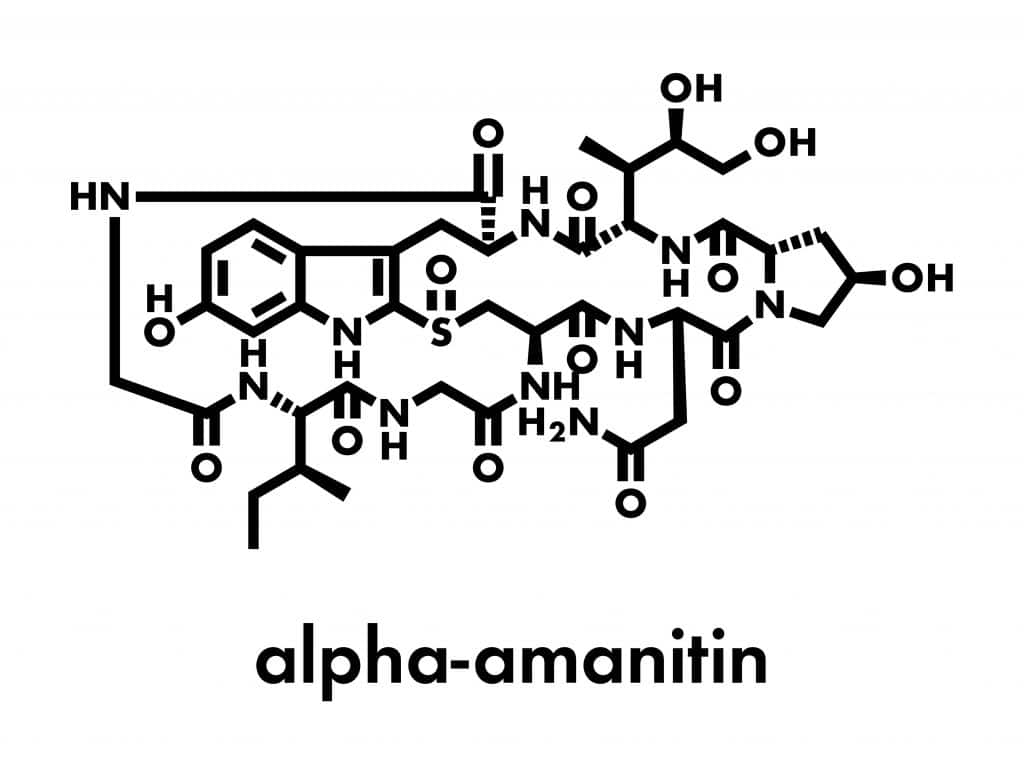
Another example of a non-amatoxin mushroom is Podostroma cornu-damae, found in parts of Asia. Though its not terribly common, its effects are quite severe. The trichothecene mycotoxins within can lead to multiple organ failure, along with abdominal pain, skin peeling, hair coming out, low blood pressure, and necrosis of the liver, along with full kidney failure. And death.
How many mushroom deaths occur?
We know some mushrooms are high in nutrients, and super good for us. We also know the wrong ones can kill us, and that a large majority of mushroom deaths are due to amatoxins. But how often does this occur? And how many people get sick without dying? Here’s a look at some information on the general incidence of death and sickness by mushrooms.
In the US, poison control centers have been keeping track of mushroom poisoning cases for over 30 years in the The National Poison Data System (NPDS). In one study from 2018, called Mushroom poisoning epidemiology in the United States, investigators looked at the years 1999-2016. According to results, there were 133,700 cases in that time; most all were intentional ingestion (83%), and most caused at most minor harm only (86%). About 704 of the cases did result in major harm. Of the 52 deaths, most were from cyclopeptide mushrooms which contain amatoxins (68-89%). The main issue across poisonings was the misidentification of mushrooms.
From China, the report Epidemiological analysis of wild mushroom poisoning in Zhejiang province, China, 2016–2018, was published in 2021, and focuses on just the one province. It found that there were 429 mushroom poisoning cases during those years in that location. Of those, 84 people required hospitalization, and two deaths occurred. The study pointed out what the above descriptions already showed, that digestive symptoms were found across the board.
France is another country which has reported a good bit on mushroom poisonings. In a Food safety News article from early October 2022, it said that in just one month up to that point, there were 60 mushroom poisonings. This seems to be a yearly occurrence in France, specifically in the latter half of the year. In 2021, from July to December, there were 1,269 mushroom poisonings according to poison control centers. Out of these, there were 41 extreme cases and four deaths. During the same months in 2020, 1,300 incidences, with 29 severe cases, and five deaths.
These are just a few examples. They show three important things: that misidentifying mushrooms is the main reason for issues; that there are plenty of cases yearly of mushroom poisoning all over the world; and that though sickness can be severe, and possibly lead to life-long complications by damaging organs, that death (luckily) only occurs a small percentage of the time. Even so, none of it sounds like a good time.
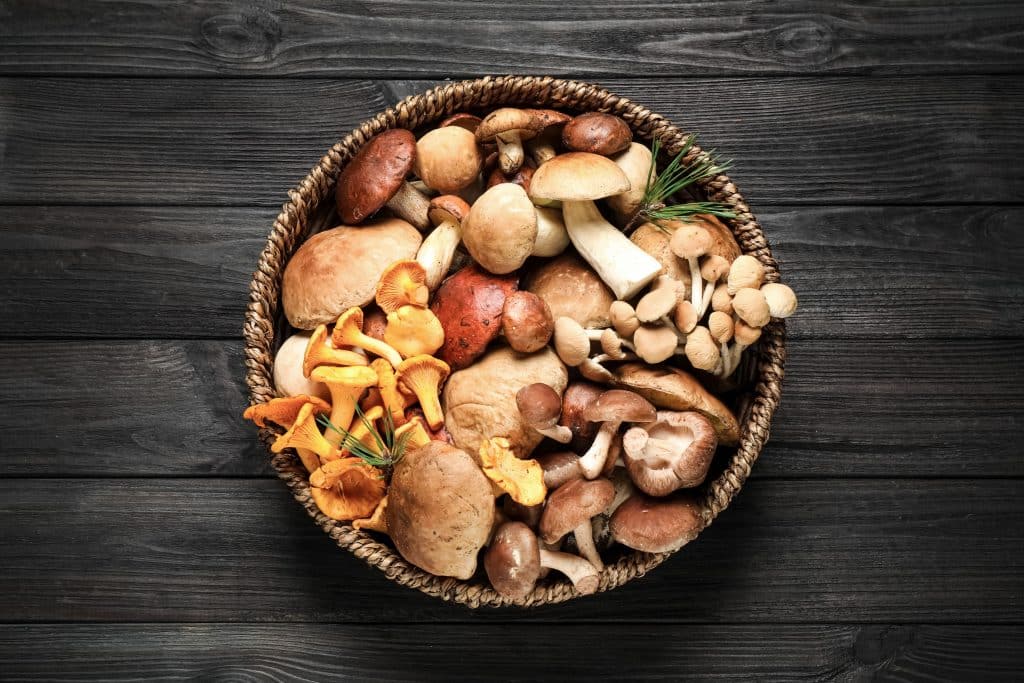
Conclusion
There are so many ways to get hurt and die in life. Mushroom deaths are certainly one you can avoid. Mushrooms can be great to eat, and get high off, but you have to know what you’re doing. It should be remembered that many mushrooms are dangerous, and often masquerade as edible or psychedelic mushrooms. Be careful, know your stuff, and enjoy the ones meant to be enjoyed. If you’re unsure of a mushroom, best to err on the side of caution, and pass it over for something else.
Welcome all! Thanks for joining us today at Cannadelics.com; a news site for independent reporting on the cannabis and psychedelics fields. Hang out with us on-the-regular to stay on-top of important stories; and subscribe to our Cannadelics Weekly Newsletter, to ensure you never miss a single thing.
Related
You may like
alpha-amanitin
What Kills You, Can Save You: Amanita Phalloides & Cancer
Published
1 year agoon
March 7, 2023By
admin
Amanita mushrooms are growing in popularity, but we’re only talking about a certain kind. Yet another kind, which is way more dangerous, is also gaining attention for its properties as a medicine. Read on to learn more about Amanita phalloides, and its possibility as a cancer fighting agent.
Amanita mushrooms
The name ‘Amanita’ refers to an entire genus of similar mushroom species. Under every genus resides different species that have something in common, while not being the same. All Amanita mushrooms are considered poisonous, though different species contain different compounds that give them varying levels of danger. Some might make you sick, some might get you high, and some might certainly kill you.
Under the Amanita genus, there’s one particular species we talk about a lot, Amanita muscaria, also known as ‘fly agaric’ mushrooms. Though there is fear for some because of their classification as poisonous mushrooms, this particular species isn’t known to kill. But it is known to cause psychoactive and hallucinogenic effects.
One of the only stories that does exist claiming these mushrooms took a life, has to do with a guy named Count de Vecchj who reportedly died after consuming a plate of the raw mushrooms. This never went past speculation as no specimen was ever tested, or the mushroom of interest, confirmed. And as it stands as literally the only story of its kind, it seem less likely that he was killed by Amanita muscaria, and more likely that another mushroom found its way into the mix.
Thanks for joining. Access our direct email updates by subscribing to the Cannadelics Weekly Newsletter, and also receive great deals on everything from cannabis buds, vapes and related equipment, to edibles, smoking devices, cannabinoid compounds (like HHC), and lots more. We’ve got it all, come get it!
Though they won’t kill a person, they can cause sickness because of a compound they contain called ibotenic acid. Luckily, ibotenic acid isn’t heat stable, and when boiled, it decarboxylates to the desired compound, muscimol. Thus, there’s a way to prepare these particular mushrooms to avoid sickness altogether.
Amanita muscaria is just one of about 600 species that reside under the genus Amanita, and a variety of them really are dangerous. Mainly because some contain compounds called amatoxins, which are incredibly toxic, and often lead to death when consumed. Unlike ibotenic acid, amatoxins can’t be minimized or avoided through boiling. Amatoxins are found in many Amanita species, as well as species under a couple other genera, like Lepiota, Galerina, and Conocybe.
It’s approximated that about 90% of all mushroom poisoning deaths, are from mushrooms that contain these amatoxins; the deadliest of which is α-amanitin. There is one particular species which is associated with up to 50% of these deaths alone, and it’s an Amanita mushroom. Amanita phalloides, appropriately nicknamed Death Cap, has the highest death toll of all the deadly mushrooms out there.
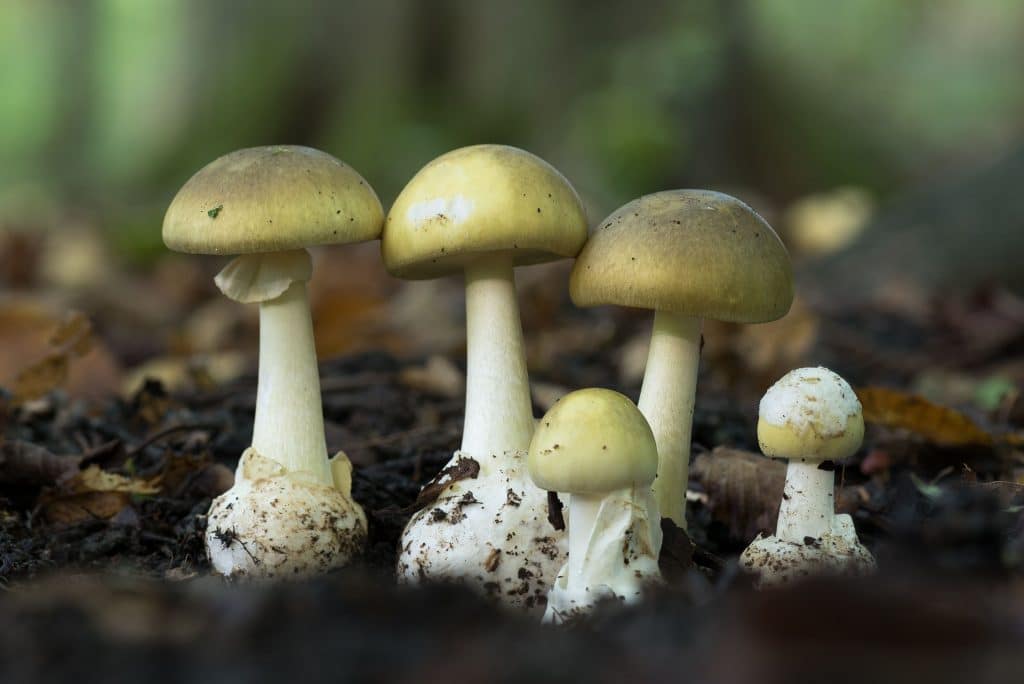
Amanita phalloides – what happens when you eat it?
Amanita phalloides contain amatoxins, like the super lethal α-amanitin. α-amanitin works by binding to RNA polymerase II irreversibly, which prevents further protein synthesis and causes dells to die. Quite unfortunately, these mushrooms resemble perfectly safe edible mushrooms, and most poisonings are due to simple misidentification. It’s not a good mistake to make, and up to 50% of poisonings with Amanita phalloides result in death.
Death by Amanita phalloides is a long and painful process. After ingestion, it takes about six hours for symptoms to come on. This is followed by a three-phase process. The first phase, dubbed the ‘dysentery phase’ lasts about 6-24 hours. As per the name, this phase looks like dysentery with the mushroom eater experiencing extreme vomiting and diarrhea. Following that there can be a false recovery stage where it seems the patient has gotten better. This can last from 24-72 hours. Last comes the hepatorenal phase, which can go on for 4-9 days, and results in multiorgan failure, seizures, coma, and finally death.
What can be done for a person poisoned by Amanita phalloides? Unfortunately, not much directly. Decontamination efforts are key, like promoting amatoxin elimination via the liver, and interrupting enterohepatic recirculation of amatoxins, using antidotes like N-acetylcysteine and silibinin. How useful these compounds are is undetermined, though, with only speculation that they might be helpful. In cases of acute liver failure, a transplant is required. Beyond that, there is no actual cure for this problem.
Amanita phalloides…for cancer treatment
If everything above makes you think it’s a bad idea to eat these mushrooms, you’re correct. There don’t seem to be any benefits attached to consuming them when it comes to personal health and survival. However, that doesn’t mean they can’t provide any benefit at all. And as it turns out, Amanita phalloides is studied for the treatment of cancer. Imagine that, taking something that’s deadly to eat, and creating a medicine out of it, for something like cancer.
Back in 2010, a study came out called Tumor Therapy with Amanita phalloides (Death Cap): Stabilization of B-Cell Chronic Lymphatic Leukemia. In it, researchers point out that in tumor cells, there’s more RNA polymerase II activity, than there’s supposed to be. And that the specific amatoxin mentioned before, α-amanitin, works by essentially slowing down or stopping RNA polymerase II. The study was done on only one patient with leukemia. He was given different doses, and his leukemic cell count was kept track of.
Results showed that “The former duplication time of leukemic cells was 21 months. Within a period of 21 months, the cell count is stabilized to around 105/μL. No leukemia-associated symptoms, liver damage, or continuous erythrocyte deprivation occur.” Researchers concluded that “This new principle of tumor therapy shows high potential to provide a gentle medical treatment.”
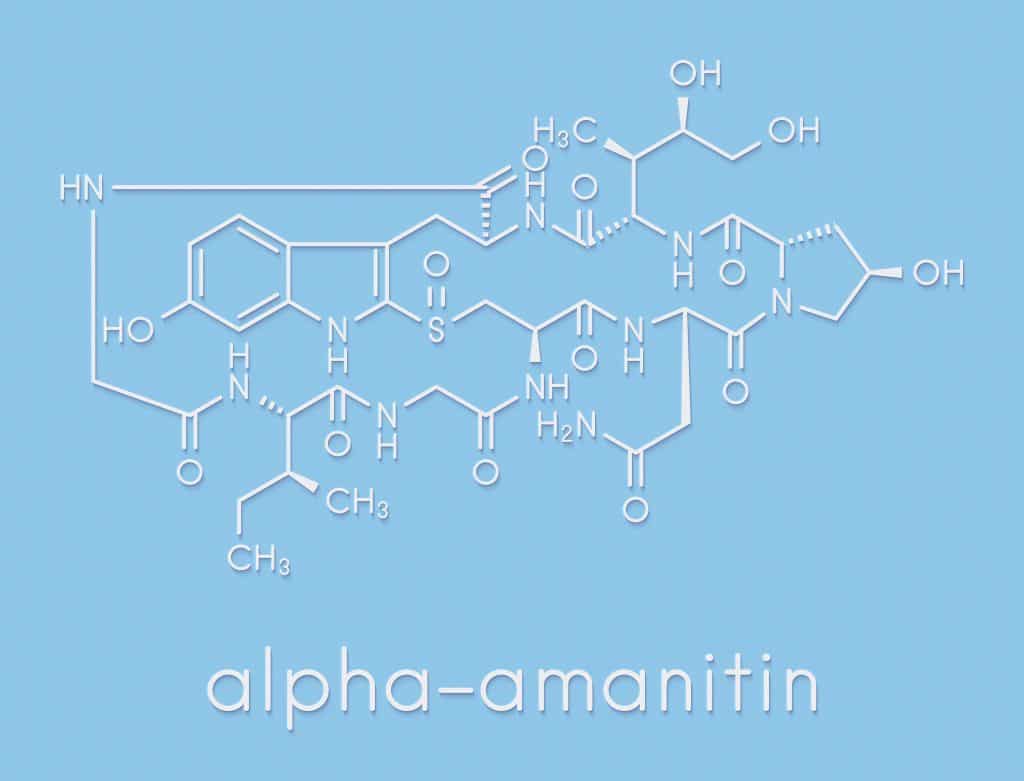
In 2021, a systematic review came out called Defining a Role of Amanita phalloides Toxins in Cancer: Research and Therapy, with the goal of examining the therapeutic benefits of α-amanitin for different kinds of cancer. The reason being that standard treatments like chemotherapy cause too much damage to healthy cells, while tumors become resistant to it. Dilutions of Amanita phalloides, noted the study, have been used for over 300 years.
The author concluded, “in recent years, α-amanitin of amanita therapy received an increased attention as a gentle medical treatment in cancer therapy is more suitable.” Almost sounds funny considering we know how dangerous these mushrooms are when used incorrectly.
The author continued, “Through my readings to different researchers’ reports, no severe side effects happen and no clinical symptoms when the patient used the amanita therapy.” And then says, “Amanitin inhibits the activity of tumor cells. Thus, α-amanita can first be used as a tumor-specific therapy. Antiandrogen drugs, chemical therapy, radiation or prostatectomy can be used at subsequent levels.”
What causes death, can save you
It truly creates what seems like a contradiction. Mushrooms we are warned away from for their deadliness, also seem able to effectively inhibit cancer, while not hurting the specimen in question. An article from 2019 is titled well, Notorious killer yields a life-saving toxin. It details how in 2014, analogues of α-amanitin from Amanita phalloides were developed by Germany’s Heidelberg Pharma, specifically to treat different kinds of cancer. The company then went on to test antibody drug conjugates (ADCs) from this poison.
The article explains, “An ADC consists of a monoclonal antibody specific to the antigen associated with the tumor cells, the cytotoxic agent, and a chemical linker. Once the ADC enters the target cells, the cytotoxic agent detaches itself from the linker, which selectively attacks the tumor cells. More specifically, a-amanitin is a bicyclic octapeptide that inhibits RNA Polymerase II (Pol II), which drives DNA transcription. It stops Pol II from producing malfunctioning proteins in the cell that drive cancer formation.” Basically, at the right low doses, it does to the cancer, what it does to kill humans; but without damage to the humans, only to the cancer.
Explains Dr. Kaveh Matinkhoo, a postdoctoral fellow, and lead investigator of the research into the creation of synthetic analogues of the compound, “Because of its mechanism of action, it can work on rapidly growing cancer cells and dormant cells. The problem is that a lot of chemotherapeutic agents only work on rapidly growing cells, and after chemotherapy is over, the patient is apparently cured but the cancer comes back a few years later.”

The trick, of course, is to use sub-lethal amounts. Think microdosing. The article goes on to talk about research involving mice in Japan, where the sub-lethal doses injected of α-amanitin, not only kept the mice from relapsing, but showed strength in dealing with chemo-resistant cancer colonies.
Conclusion
It does make sense. If the α-amanitin compound of Amanita phalloides is strong enough to kill humans, why couldn’t it be strong enough to kill cancer? In the future, we might find ourselves being treated, with the same mushrooms that can kill us.
Welcome readers! Always great to have you with us at Cannadelics.com; where we provide independent coverage of the burgeoning cannabis and psychedelics spaces. Head our way whenever you’ve got a minute to stay informed on everything going on; and sign up to the Cannadelics Weekly Newsletter, to ensure you’re on top of every story.
Related

All The Ways To Consume Cannabis

5 Best Ways to Break The Doomscrolling Habit

Marijuana MicroDosing Can Improve Mundane Tasks

10 Coloradans could win the rights to license plates with cannabis-themed phrases

Unleashing the Therapeutic Potential of High CBD Seeds

The Guide to Stoned Parenting

Nearly 50% of Biden Supporters Want a Dispensary Within Driving Distance, Only 12% of Trump Supporters Feel the Same Way

How To Use Bomb Pro Electric Dab Rig
Biden & Trump voters’ cannabis views (Newsletter: April 24, 2024)

The Best 6 Ways To Increase Creativity At Work

Distressed Cannabis Business Takeaways – Canna Law Blog™

United States: Alex Malyshev And Melinda Fellner Discuss The Intersection Of Tax And Cannabis In New Video Series – Part VI: Licensing (Video)

Drug Testing for Marijuana – The Joint Blog

What you Need to Know

Cannabis, alcohol firm SNDL loses CA$372.4 million in 2022

NCIA Write About Their Equity Scholarship Program

City Of Oakland Issues RFP For Employee Training Programs

It has been a wild news week – here’s how CBD and weed can help you relax

A new April 20 cannabis contest includes a $40,000 purse

UArizona launches online cannabis compliance online course
Trending
-

 Cannabis News1 year ago
Cannabis News1 year agoDistressed Cannabis Business Takeaways – Canna Law Blog™
-

 One-Hit Wonders1 year ago
One-Hit Wonders1 year agoUnited States: Alex Malyshev And Melinda Fellner Discuss The Intersection Of Tax And Cannabis In New Video Series – Part VI: Licensing (Video)
-

 drug testing4 months ago
drug testing4 months agoDrug Testing for Marijuana – The Joint Blog
-

 Cannabis 1011 year ago
Cannabis 1011 year agoWhat you Need to Know
-

 Marijuana Business Daily1 year ago
Marijuana Business Daily1 year agoCannabis, alcohol firm SNDL loses CA$372.4 million in 2022
-

 Education1 year ago
Education1 year agoNCIA Write About Their Equity Scholarship Program
-

 Education1 year ago
Education1 year agoCity Of Oakland Issues RFP For Employee Training Programs
-

 Cannabis1 year ago
Cannabis1 year agoIt has been a wild news week – here’s how CBD and weed can help you relax



